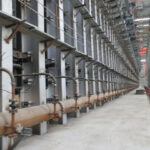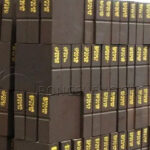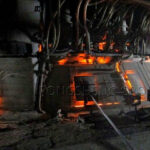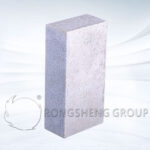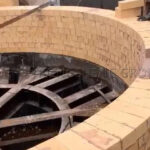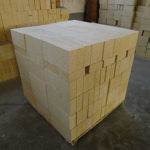The design of the regenerative grate in a glass melting furnace is a crucial aspect of the overall furnace design. A well-designed grate can significantly increase the preheating temperature of the combustion air, resulting in higher combustion temperatures for the fuel and thus aiding combustion and heating throughout the furnace. It also allows for greater recovery of waste heat from flue gas and lower exhaust gas temperatures. Furthermore, it reduces the volume of combustion exhaust gas, thereby decreasing emissions of harmful substances such as nitrogen oxides, sulfur and its oxides, and particulate matter, resulting in a significant environmental protection benefit.
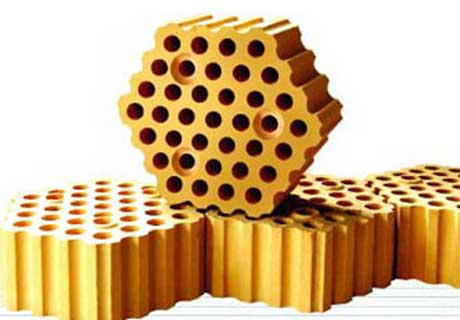
Basic Information on the Regenerator Chamber Checker Bricks Structure
The checkerboard structure of the glass melting furnace regenerator chamber is constructed using standard checker bricks. These bricks are uniform in size, inexpensive, and have a short delivery time. The refractory material used to produce the checker bricks should have high density and high thermal conductivity to ensure sufficient heat storage and exchange capacity. Setting the preheating temperature of the combustion air and the exhaust gas temperature are crucial prerequisites for checker bricks design.
The function of the regenerator chamber is to exchange the waste heat from the flue gas discharged from the melting zone of the glass melting furnace with the combustion air, thus recovering waste heat. The type of checker bricks, their arrangement, the size of the checkerboard pores, the wall thickness (brick thickness), and the material of the checker bricks all affect the heat transfer performance of the checkerboard structure. The type of fuel plays a significant role in flue gas radiation and is also a factor affecting the heat transfer performance of the checkerboard structure.
From a thermal engineering perspective, the size of the checkerboard pores directly affects heat exchange; smaller pore sizes result in a larger unit heated area and greater heat exchange capacity. However, from an operational perspective, smaller apertures increase gas flow resistance. Furthermore, the likelihood of blockage due to ultrafine powder in the feedstock or dripping slag also increases, affecting the heat exchange capacity of the lattice.
Operating Conditions of the Regenerator Chamber in a Glass Melting Furnace
The operating conditions in the regenerator chamber of a glass melting furnace are extremely harsh. It must withstand the erosion of high-temperature alkaline vapors, flue gas, and various solid fly particles, as well as the thermal shocks caused by the reversal of combustion air and flue gas. The lower bricks also bear the heavy pressure from the upper bricks. The conditions can be broadly categorized as follows:
- ① Gas erosion from high-temperature alkaline vapors and flue gas.
- ② Solid erosion from acidic and alkaline dust fly particles in the batch materials, and harmful impurities in the fuel.
- ③ Liquid erosion from liquid sulfates in the condensation zone.
- ④ Structural and thermal stresses caused by alternating temperature changes during reversal lead to fatigue failure of the bricks.
- ⑤ Chemical reactions in oxidizing and reducing atmospheres damage the structure and crystal phases of the bricks.
- ⑥ The lower bricks bear the heavy pressure from the upper bricks, generating significant compressive stress.
Support Layer for the Grate Structure
The regenerator grate structure cannot be directly built onto the leveling bricks of the grate arch because the center-line spacing between adjacent grate arches in the transverse direction is twice the grate module. The width of the grate arch is only 150mm, and the spacing between them generally exceeds the external dimensions of the grate bricks. A single grate arch cannot directly support two rows of grate bricks simultaneously, so a layer of grate support bricks is used for transition. Structurally, this is equivalent to adding a transition beam above two adjacent grate arches. The grate bricks can only be laid on top of the support bricks according to the grate module.
The grate support bricks are inverted U-shaped with retaining brackets at both ends. The upper length of the support brick is approximately twice the grate module. The lower retaining bracket length is approximately the spacing between two grate arches. The support bricks must be evenly stacked above the top surface of the grate arch leveling layer according to the grate module dimensions. This design allows for the fixing of adjacent grate arches at intervals of the support platform length, while also creating a suitable stacking platform on the top surface of the support bricks for the grid module.
The upper length of the inverted U-shape of the grid support bricks should be slightly smaller than twice the grid module. This is because thermal expansion needs to be considered, and a 5mm reduction in gap dimension is generally required. The support bricks near the inner and outer walls have different support platform dimensions at both ends, resulting in slightly different brick lengths, requiring design adjustments based on specific circumstances. The height of the regenerator grid includes the height of the support layer.
Aperture Dimensions of the Regenerator Grate in a Glass Melting Furnace
To achieve the set preheating temperature of the combustion air, the regenerator chamber of a glass melting furnace must have a suitable grate volume and heat exchange area. The aperture size of the grate plays a crucial role in the volume, length, width, and height of the grate, and also significantly affects its heat exchange efficiency.
Based on the actual situation in China where glass batches contain a high content of ultrafine powder, the aperture size of the regenerator grate should be 150–170 mm. In most domestic glass melting furnaces, the actual practice is to use a 160 mm aperture for cylindrical bricks and a 165 mm aperture for strip bricks. This is the result of long-term production practice and optimization, and has been matured and established.
The “Reasonable Value” of the Horizontal Cross-sectional Area of the Regenerator Chamber’s Lattice
The volume of the lattice chamber is determined by the product of its horizontal cross-sectional area and height. The horizontal cross-sectional area is closely related to the number of furnace pairs, the centerline spacing of the furnaces, and the internal width of the regenerator chamber. The horizontal cross-sectional area of the lattice chamber in glass melting furnaces of different tonnages and energy consumptions should each have a corresponding “reasonable value.” This reasonable value is not a uniquely determined numerical value, but rather a series of discontinuous but closely approximate values within a relatively narrow range.

This is because the length and width dimensions of the lattice chamber are determined according to the modular dimensions of the checker bricks. Different types of checker bricks have different aperture and wall thickness dimensions, resulting in discontinuous length and width dimensions for the lattice chambers arranged according to these modular dimensions. Therefore, the product of the length and width dimensions is even more discontinuous. Given the diversity of checker brick parameters, the concept of a “reasonable value” is more accurate here.
If any one (or more) of the following three dimensions—the number of furnace pairs, the centerline spacing of the furnaces, and the width of the regenerator chamber—is improperly designed, the horizontal cross-sectional area of the lattice may deviate from the “reasonable value.” This will cause changes in the airflow distribution and velocity within each grid cell, thus affecting the overall heat transfer coefficient of the lattice. Based on the current situation of glass melting furnace regenerators in China,
cases of areas being smaller than the “reasonable value” are extremely rare, while cases of areas being larger are more common. If the area is smaller than the “reasonable value,” the height of the lattice needs to be increased; otherwise, the heat transfer capacity will be insufficient. If the area is larger than the “reasonable value,” the gas flow rate within each grid cell will decrease, the airflow velocity will also decrease, and the heat transfer coefficient of the lattice will also decrease. Although increasing the horizontal cross-sectional area of the lattice increases its volume, the actual heat transfer capacity does not increase proportionally, or even by much. If the area is significantly larger than the “reasonable value,” a substantial increase in unit energy consumption may be required to ensure the normal operation of the melting furnace.
Height of the Regenerator Grate
The height of the regenerator grates in glass melting furnaces has gradually increased over time. Early glass melting furnace regenerator grates were very low, mainly due to limitations in the performance of the refractory materials used at the time. Later, the height gradually increased; 50-60 years ago, the height of the air regenerator grates reached 5-6 meters. 30-40 years ago, the height reached approximately 8 meters, and it can continue to increase in height.
With the continuous improvement of the performance of the regenerator grates’ refractory materials and the increasingly urgent requirements for energy conservation and emission reduction, the grates should be further increased in height. Currently, the height of the regenerator grates in most domestic glass melting furnaces is around 8 meters, corresponding to a combustion air preheating temperature of approximately 1100 ℃ and an exhaust gas temperature of approximately 600 ℃. Increasing the height of the heat storage chamber to 9-10 meters can raise the combustion air temperature to around 1200°C and lower the exhaust gas temperature to around 500°C, achieving energy savings and emission reductions of approximately 5%. However, increasing the height of the heat storage chamber will also increase investment in plant infrastructure, requiring comprehensive consideration.
Traditional Approaches to Grate Design in Glass Melting Furnace Regenerators
Heat transfer within the grating is complex and unstable, making grating design using heat transfer calculations very difficult. Early grating designs used the melting zone area as a baseline, determining the grating heat exchange area by multiplying it by 25 to 45 times, resulting in a large and coarse range. Later, empirical practices and formulas emerged, using the required combustion air (fuel gas) volume per second for furnace operation as the baseline. This approach improved accuracy and was simpler and more practical.
A previously renowned international supplier of sintered refractory materials proposed an empirical approach that uses the combustion air volume per second as the calculation baseline. Based on the grating aperture size, a fixed volume of grating is configured according to the required combustion air volume per second (Nm³/s). This can be referred to as the “grate volume variable per unit combustion air volume.” Based on this volume variable and the unit combustion air volume, the lattice volume of the regenerator on one side of the furnace can be calculated. Then, the lattice design can be performed according to other given conditions.
An empirical formula proposed by an American company also uses the combustion air volume per second as the calculation base. Based on the required preheating temperature of the combustion air, a fixed amount of heat exchange area is configured for the lattice according to the combustion air volume in Nm³/s. This can be called the “unit combustion air lattice heat exchange area variable,” and a high-power calculation formula for the combustion air preheating temperature is given based on this heat exchange area variable.
When using the empirical formula from the American company for lattice design, the preheating temperature of the combustion air must first be determined. Then, the “unit combustion air lattice heat exchange area variable” that can achieve this preheating temperature is calculated using the high-power calculation formula (sometimes requiring trial calculations and adjustments). Then, based on the calculated heat exchange area variable and the unit combustion air volume required by the furnace, the required heat exchange area of the lattice in the regenerator on one side is calculated. Finally, the lattice design is completed according to other given conditions. An empirical formula from an American company is directly linked to the heat exchange area of the lattice, which is more in line with actual heat exchange conditions.
Simplified Formula for Regenerator Grate Design
Although the heat transfer in a glass melting furnace regenerator is unstable, the total heat released by the flue gas and the total heat absorbed by the combustion air remain relatively stable throughout each reversing cycle. This stable total heat transfer can be expressed by the formula: Heat Transfer = Heat Transfer Coefficient × Heat Transfer Area × Temperature Difference. Based on the required preheating temperature of the combustion air, the total heat transfer required by the glass melting furnace can be calculated through grating heat balance calculations. If the total heat transfer coefficient of the grating (unit: kcal/(m²·cycle·℃)) and the logarithmic mean temperature difference between the flue gas and the combustion air can be calculated, the required total heat transfer area of the grating can be determined. Furthermore, the volume of the grating can be calculated, making the grating design easy.
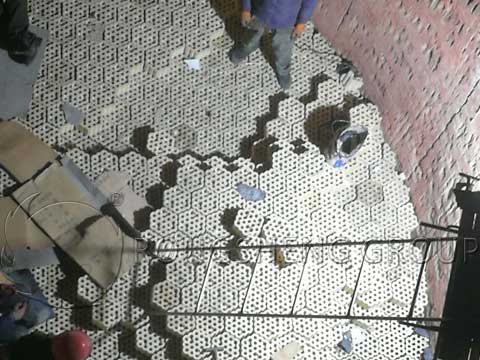
Material Selection for Checker Bricks Used in Glass Melting Furnace Regenerators
Alkaline bricks, used as checker materials, have high heat storage and exchange capabilities. Since the 1950s, alkaline refractories have been used in glass melting furnace regenerators abroad, and gradually adopted in China in the 1980s. Different refractory materials are selected based on the varying temperatures at different heights of the checker, the amount of dust and fly ash in the flue gas, and temperature cycle variations.
Alkaline bricks can meet the increasingly stringent operating conditions of glass melting furnace regenerators, hence their increasingly widespread use in recent years. In the high-temperature zone (1100–1450℃) of the checker, low-iron fired magnesia bricks with good stacking structure, specifically fused magnesia bricks of grade DMZ-97, are used.
In the mid-temperature zone (800–1100℃) of the checker, the magnesia bricks are subject to significant chemical corrosion from alkaline sulfates and SO3. Changes begin at the brick surface, where MgO and CaO diffuse away or volatilize. This erosion thins the checker bricks, eventually jeopardizing the stability of the checker structure. In the upper half of this temperature range, fused magnesia bricks (DMZ-95) can be used. In the lower half, directly bonded magnesia-chrome bricks (DMC-12) can be used.
In the low-temperature zone of the checker structure (below 800℃), low-porosity clay bricks (ZGN-42 bricks, 42% Al₂O₃) with good resistance to thermal shock have performed well.
Common Types and Arrangements of Checker Bricks for Glass Melting Furnaces
There are various types of checker bricks used in regenerators, the most common being strip bricks (also called straight bricks), cylindrical bricks, and cross-shaped bricks. Less commonly used are I-shaped and C-shaped aggregate bricks, channel bricks, and chimney-shaped bricks. Previously, strip bricks were the most commonly used checker bricks in glass melting furnace regenerators, with arrangements including: straight grate arrangement, diagonally staggered grate arrangement, woven basket arrangement, and a combination of woven baskets and grate arrangements. Strip bricks are 65mm thick, 230-375mm long, and 114mm high. The most commonly used checker hole size is 165mm, with a maximum height error of ±0.5mm. Large height errors will cause uneven stress on the brick surface, leading to tilting and collapse of the checker even with precise stacking. Strip brick checker bricks with commonly used hole sizes of 150-200mm are recommended for glass melting furnace regenerators with a design life of 8-12 years.
Over the past 20 years, the application of cylindrical checker bricks (octagonal cylindrical bricks) in domestic glass melting furnaces has developed rapidly. The wall thickness of cylindrical checker bricks is typically 40mm. They offer advantages such as large unit heating area, strong heat exchange capacity, light weight, large flow area of the checker holes, and good structural stability. Commonly used checker brick aperture sizes are 140-170mm. For glass melting furnace regenerators with a design life of 5-8 years, domestically produced cylindrical checker bricks are recommended. This is because the wall thickness of 40mm cylindrical checker bricks gradually decreases due to erosion, affecting the heat exchange capacity and safety of the checker. High-grade imported cylindrical checker bricks can also achieve a furnace life of around 10 years.
Cross-shaped checker bricks have been used in glass melting furnaces abroad for over 40 years (developed successfully in 1973). Cross-shaped checker bricks typically have a wall thickness of 38/40mm. The surface of the cross-shaped brick flanges is smooth or corrugated, resulting in a high heat transfer coefficient per unit volume of checker. The checker bricks are made of fused zirconia-corundum bricks (1682) and fused alumina bricks (5312). They exhibit excellent resistance to chemical erosion and thermal erosion. The checker holes have a large flow area, and the cross-shaped structure offers good stability and the longest service life, up to twice that of other bricks. The commonly used aperture size for cross-shaped checker bricks is 140/170 mm. Cross-shaped checker bricks are recommended for glass melting furnace regenerators with a design life of 10-15 years.

